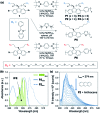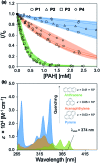A sensor array for the discrimination of polycyclic aromatic hydrocarbons using conjugated polymers and the inner filter effect
- PMID: 32110311
- PMCID: PMC7020785
- DOI: 10.1039/c9sc03405f
A sensor array for the discrimination of polycyclic aromatic hydrocarbons using conjugated polymers and the inner filter effect
Abstract
Natural and anthropogenic activities result in the production of polycyclic aromatic hydrocarbons (PAHs), persistent pollutants that negatively impact the environment and human health. Rapid and reliable methods for the detection and discrimination of these compounds remains a technological challenge owing to their relatively featureless properties, structural similarities, and existence as complex mixtures. Here, we demonstrate that the inner filter effect (IFE), in combination with conjugated polymer (CP) array-based sensing, offers a straightforward approach for the quantitative and qualitative profiling of PAHs. The sensor array was constructed from six fluorescent fluorene-based copolymers, which incorporate side chains with peripheral 2-phenylbenzimidazole substituents that provide spectral overlap with PAHs and give rise to a pronounced IFE. Subtle structural differences in copolymer structure result in distinct spectral signatures, which provide a unique "chemical fingerprint" for each PAH. The discriminatory power of the array was evaluated using linear discriminant analysis (LDA) and principal component analysis (PCA) in order to discriminate between 16 PAH compounds identified as priority pollutants by the US Environmental Protection Agency (EPA). This array is the first multivariate system reliant on the modulation of the spectral signatures of CPs through the IFE for the detection and discrimination of closely related polynuclear aromatic species.
This journal is © The Royal Society of Chemistry 2019.
Figures







References
-
- Harvey R. G., Polycyclic Aromatic Hydrocarbons, Wiley-VCH, New York, 1997.
- Abdel-Shafy H. I., Mansour M. S. M. Egypt. J. Pet. 2016;25:107.
-
- Kim K. H., Jahan S. A., Kabir E., Brown R. J. C. Environ. Int. 2013;60:71. - PubMed
- Mastral A. M., Callén M. S. Environ. Sci. Technol. 2000;34:3051.
-
- World Health Organization, WHO guidelines for indoor air quality: selected pollutants, WHO Regional Office for Europe, Copenhagen, 2010. - PubMed
- Menzie C. A., Potocki B. B., Santodonato J. Environ. Sci. Technol. 1992;26:1278.
-
- Dixon H. M., Scott R. P., Holmes D., Calero L., Kincl L. D., Waters K. M., Camann D. E., Calafat A. M., Herbstman J. B., Anderson K. A. Anal. Bioanal. Chem. 2018;410:3059. - PMC - PubMed
- Paulik L. B., Donald C. E., Smith B. W., Tidwell L. G., Hobbie K. A., Kincl L., Haynes E. N., Anderson K. A. Environ. Sci. Technol. 2016;50:7921. - PMC - PubMed
- Kumar S., Negi S., Maiti P. Environ. Sci. Pollut. Res. 2017;24:25810. - PubMed
-
- Wise S. A., Sander L. C., May W. E. J. Chromatogr. 1993;642:329.
- Lung S. C. C., Liu C. H. Sci. Rep. 2015;5:12992. - PMC - PubMed
- Purcaro G., Moret S., Miklavcic M. B., Conte L. S. J. Sep. Sci. 2012;35:922. - PubMed
- Dost K., Ideli C. Food Chem. 2012;133:193.
- Toriba A., Kuramae Y., Chetiyanukornkul T., Kizu R., Makino T., Nakazawa H., Hayakawa K. Biomed. Chromatogr. 2003;17:126. - PubMed
LinkOut - more resources
Full Text Sources
Other Literature Sources
Research Materials
Miscellaneous

